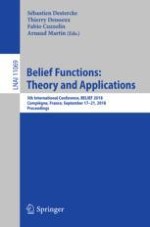2018 | OriginalPaper | Buchkapitel
Logistic Regression Revisited: Belief Function Analysis
verfasst von : Thierry Denoeux
Erschienen in: Belief Functions: Theory and Applications
Aktivieren Sie unsere intelligente Suche, um passende Fachinhalte oder Patente zu finden.
Wählen Sie Textabschnitte aus um mit Künstlicher Intelligenz passenden Patente zu finden. powered by
Markieren Sie Textabschnitte, um KI-gestützt weitere passende Inhalte zu finden. powered by
